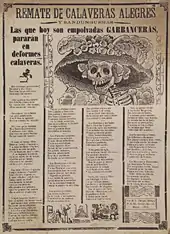Literary Calavera
The Literary Calavera or calavera literaria (Spanish: literary skull) is a traditional Mexican literary form: a satirical or light-hearted writing in verse, often composed for the Day of the Dead.[1][2]

Posada's La Calavera Garbancera together with a literary calaverita in 1913
History
Initially known as panteones, these verses had their origin in the 19th century as mocking epitaph and a way of expressing ideas or feelings that in other occasions might be difficult to express.[3][2] For this reason they were often censored or destroyed, since they also often served as a means to express political satire.[3][2] The first calaveras were published in 1879, in the newspaper El Socialista, of Guadalajara.[2]
Features
References
- Argüelles, Juan Domingo (2 November 2003). "La adulteración de las calaveras". La Jornada en línea. Retrieved 10 October 2012.
- González, Carmen (16 October 2008). "Son las calaveras literarias una manifestación de la cultura popular". El Sol de Tlaxcala. Retrieved 10 October 2012.
- Marroquín, Fausto Martínez. ""Calaveritas", una hermosa y casi desaparecida tradición". México desconocido. Retrieved 10 October 2012.
- "Qué es una calavera literaria | Calaveras Literarias". calaveras-literarias.com. 5 October 2020. Retrieved 12 October 2020.
- "Características de las calaveras literarias | Calaveras Literarias". calaveras-literarias.com.mx. 26 October 2013. Retrieved 12 October 2020.
This article is issued from Wikipedia. The text is licensed under Creative Commons - Attribution - Sharealike. Additional terms may apply for the media files.